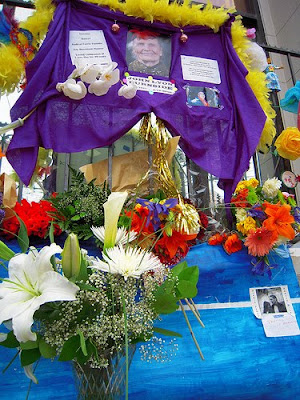
Mr. Burnside was born November 2, 1916, in Seattle.
An only child, he was raised by his mother after his
father left the family; being poor, she periodically
placed her son in the care of orphanages.
Mr. Burnside joined the Navy at age 16. Soon after
his discharge, he settled in Los Angeles and married
Edith Sinclair; the couple had no children. He studied
physics and mathematics at the University of California
at Los Angeles, graduating in 1945. He pursued a career
in the aircraft industry, including a stint as a staff
scientist at Lockheed.
Mr. Burnside's interest in optical engineering led him to
invent the teleidoscope, a type of kaleidoscope that works
without colored glass chips. He received a patent on the
device, which brought him considerable income. In 1958,
he started his own company, California Kaleidoscopes. He
later created the symetricon, a large kaleidoscopic device
that projects patterns, which was used in several Holly-
wood films. Mr. Burnside began coming to terms with his
attraction for men in the 1960s. Some gay workers at the
kaleidoscope workshop told him about the ONE Institute,
and he began attending classes. There, in 1963, Mr.
Burnside (then age 47) met Mr. Hay (then 51), who was
promoting a gay square dancing group.
The two embarked on a whirlwind romance that
led to Mr. Burnside divorcing his wife and moving
in with Mr. Hay. Together, Mr. Burnside and Mr.Hay
participated in many of the key events of the
burgeoning gay movement. In May 1966, they were
part of a 15-car motorcade through downtown Los
Angeles to protest the military's exclusion of
homosexuals. In 1969, they attended the founding
meetings of the Southern California Gay Liberation Front.
In 1970, Mr. Burnside and Mr. Hay moved to San Juan
Pueblo, New Mexico, drawn by their involvement in the
Indian Land and Life Committee and Mr. Hay's growing
interest in Native American culture, in particular the
two-spirit people. Like Mr. Hay, Mr. Burnside came to
see gay people as a distinct group with a particular role
in society. "The crown of gay being is a way of loving,
of reaching to love in a way that far transcends the
common mode," he wrote in 1989.
In 1979, frustrated with the gay movement's drift
toward mainstream assimilation, Mr. Burnside and
Mr. Hay, along with fellow activists Don Kilhefner and
Mitch Walker, organized the first Spiritual Gathering
of Radical Faeries. Since that first gathering of 200
men at an ashram near Tucson, the faerie movement
has held dozens of gatherings around the world and
established permanent sanctuaries across the country.
In 1970, Mr. Burnside and Mr. Hay moved to San Juan
Pueblo, New Mexico, drawn by their involvement in the
Indian Land and Life Committee and Mr. Hay's growing
interest in Native American culture, in particular the
two-spirit people. Like Mr. Hay, Mr. Burnside came to
see gay people as a distinct group with a particular role
in society. "The crown of gay being is a way of loving,
of reaching to love in a way that far transcends the
common mode," he wrote in 1989.
In 1979, frustrated with the gay movement's drift
toward mainstream assimilation, Mr. Burnside and
Mr. Hay, along with fellow activists Don Kilhefner
and Mitch Walker, organized the first Spiritual
Gathering of Radical Faeries. Since that first
gathering of 200 men at an ashram near Tucson,
the faerie movement has held dozens of gatherings
around the world and established permanent
sanctuaries across the country.
John was also a poet and here as he recites : Learning
Burning Yearning" some of his life with Harry Hay goes by.
Mr. Burnside and Mr. Hay were among the first long-
term gay male couples in the public eye, and thus
served as role models for countless LGBT people.
As early as 1967, they appeared together on the Joe
Pyne television show in Los Angeles. They were
featured in the groundbreaking 1977 documentary
Word is Out, as well as the 2002 biographical
documentary Hope Along the Wind . "People mostly
remember him as Harry Hay's partner, but John was
his own very powerful and very creative person,"
said Hope Along the Wind director Eric Slade.
In 1999, Mr. Burnside and Mr. Hay came to San
Francisco, where Mr. Hay had been selected as grand
marshal of that year's Pride parade. After Mr. Hay
became too ill to return to Los Angeles, friends
helped the couple to relocate to the city. Mr. Burnside
became a familiar presence, never missing the weekly
Faerie Coffee Circles at the San Francisco LGBT Comm-
unity Center.
Although they maintained a loving partnership for
nearly 40 years, Mr. Burnside and Mr. Hay had an
open relationship and expressed no interest in legal
marriage. John and Harry, along with Del Martin and
Phyllis Lyon, symbolized for a whole generation the
possibility that two gay people could sustain a
committed, long-term loving relationship. John
had no interest in imitating society's rules. He
believed that gay people would create new forms
of relations that were suited to their unique ways
of loving one another. Indeed, Mr. Burnside and
Mr. Hay created around themselves a broad
community of friends, lovers, and supporters.
A group of Radical Faeries dubbed the Circle of
Loving Companions cared for the two men during
their final years.
A spontaneous memorial for Mr. Burnside has been set up
at the corner of 18th and Castro streets San francisco.
A public memorial service is being planned. In accor-
dance with his wishes, Mr. Burnside's ashes will be
co-mingled with those of Mr. Hay and scattered at
the Nomenus Radical Faerie Sanctuary in Wolf Creek,
Oregon. Donations in Mr. Burnside's memory may be
made to the Harry Hay Fund, which will continue their
work toward gay liberation. The Harry Hay Fund,
c/o Chas Nol, 174 1/2 Hartford Street,
San Francisco, CA 94114.




No comments:
Post a Comment